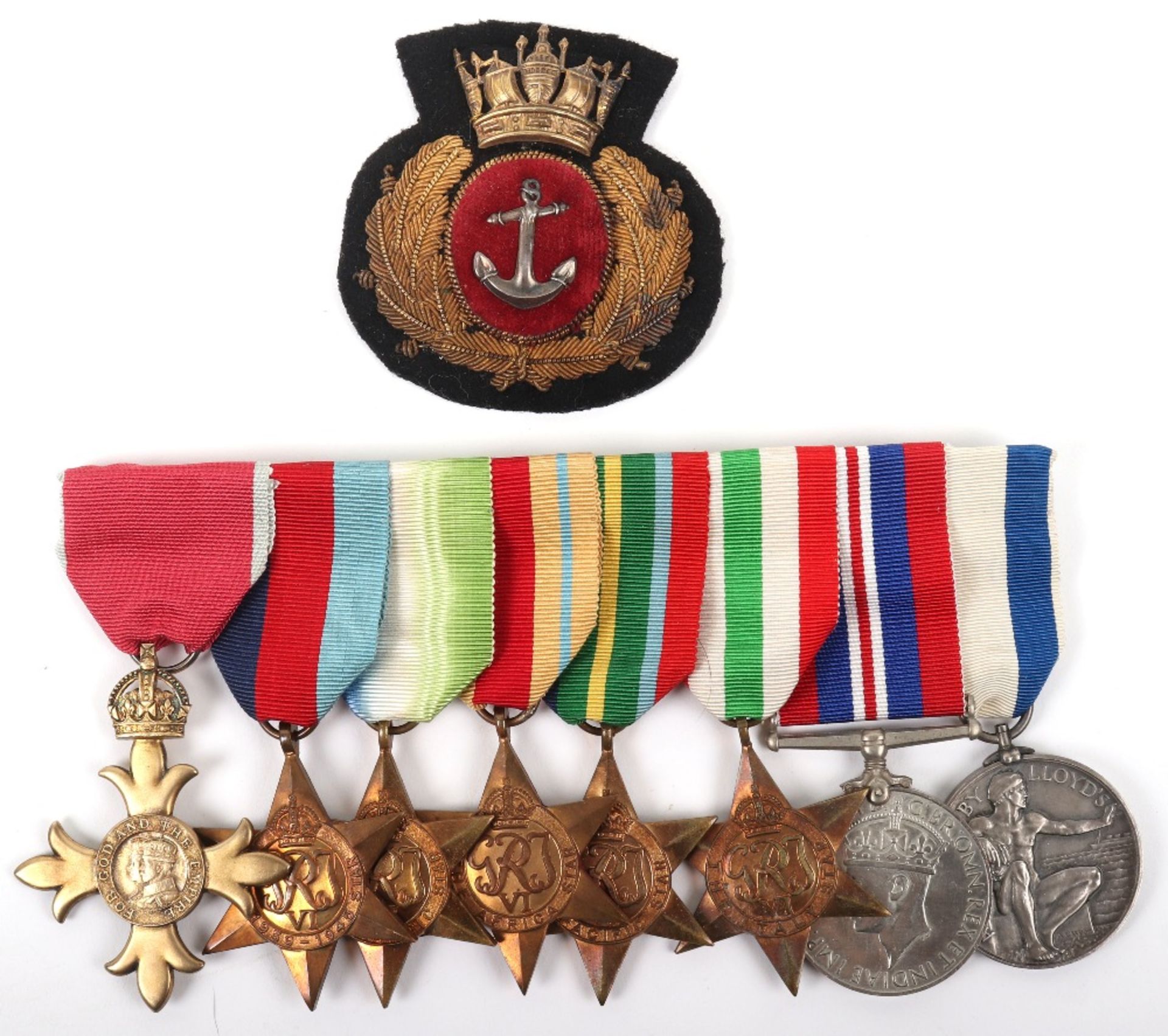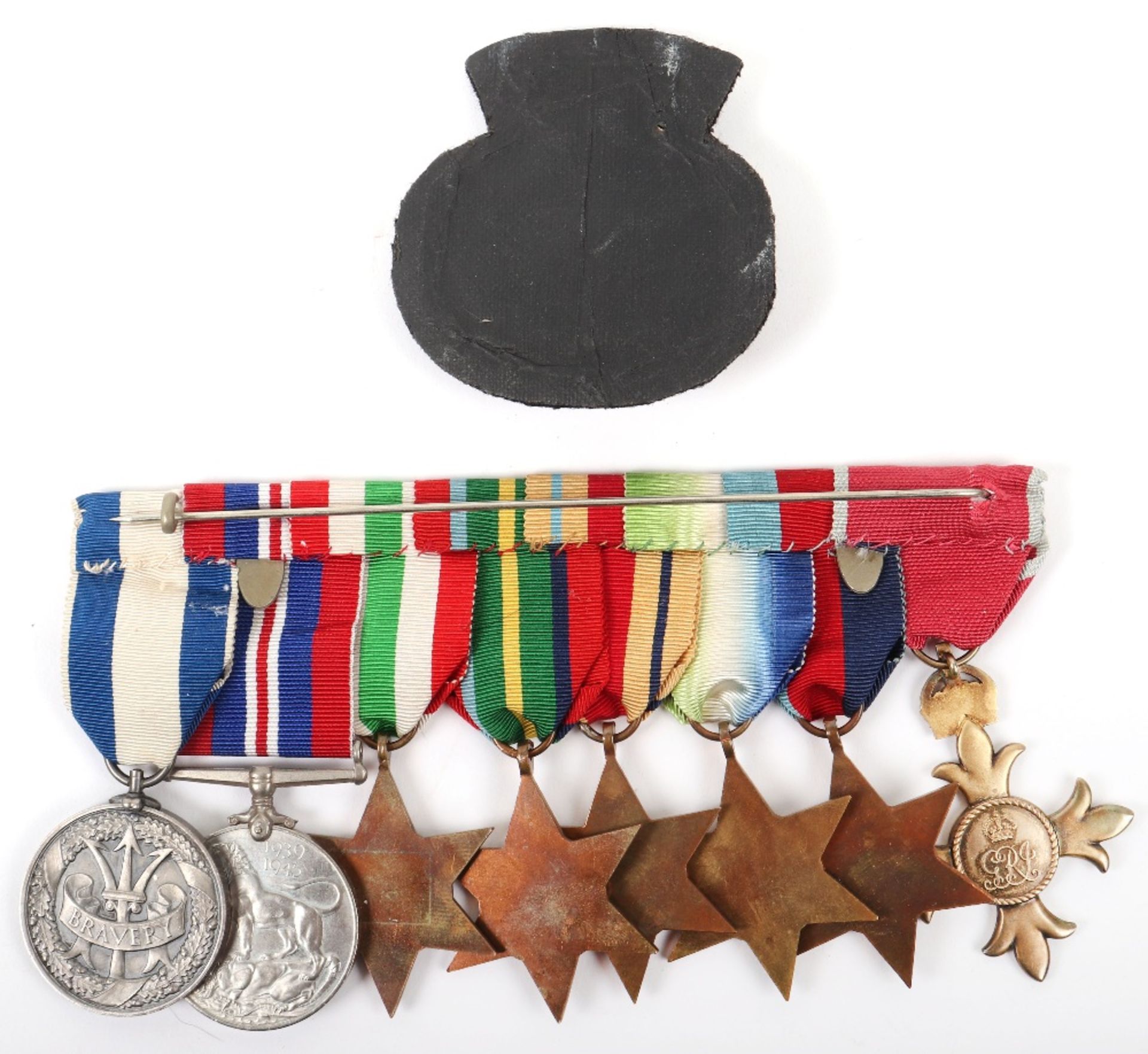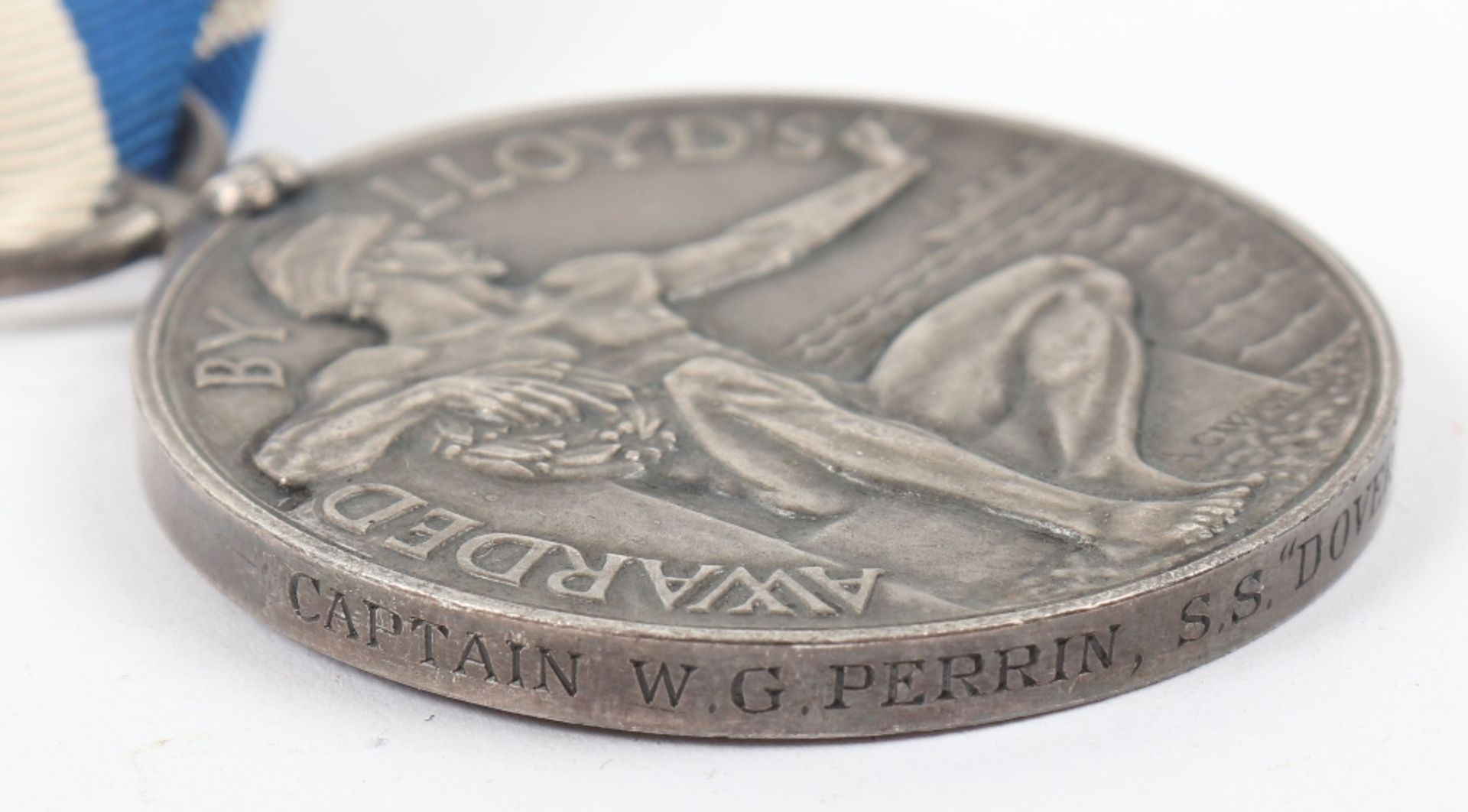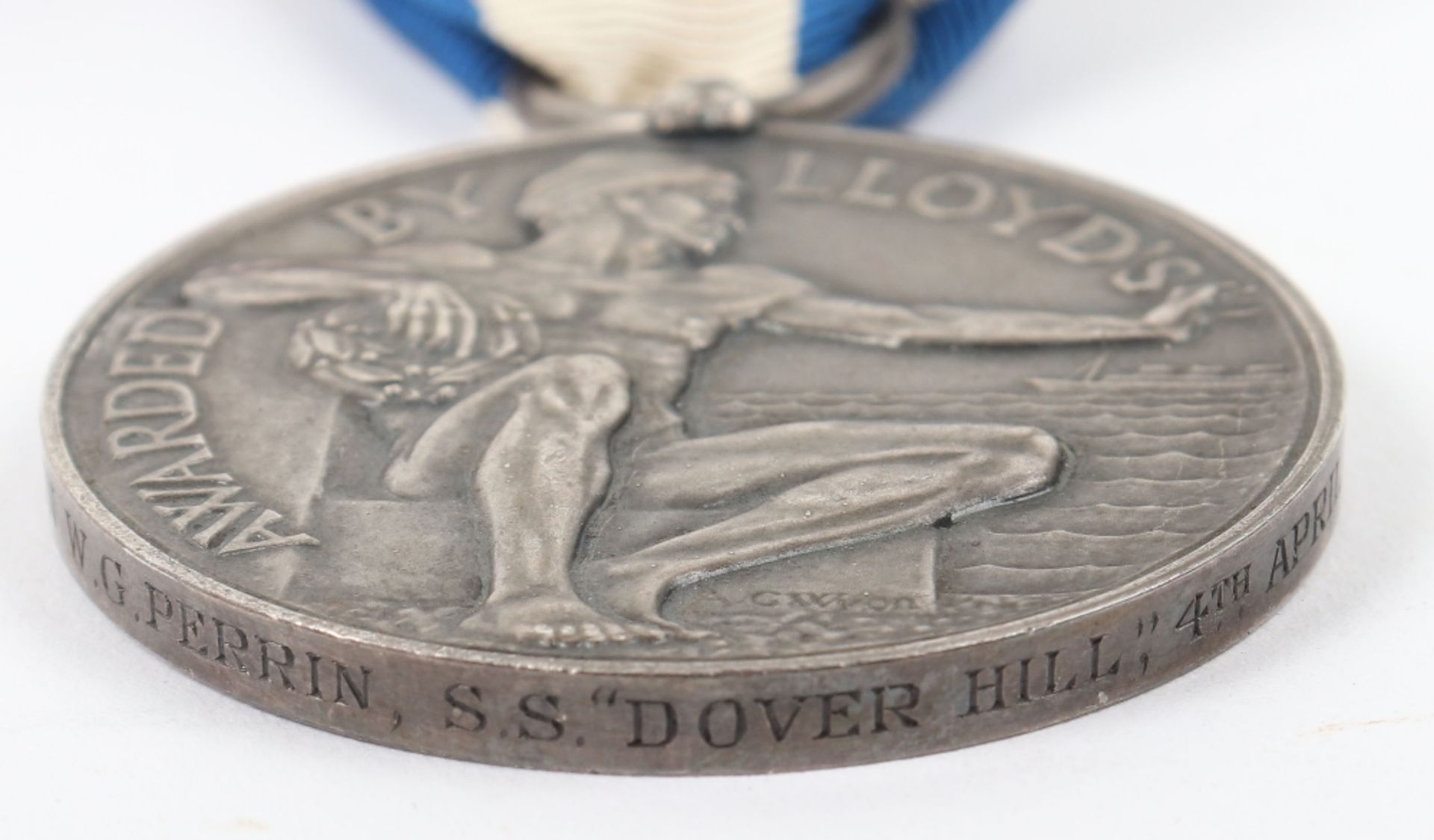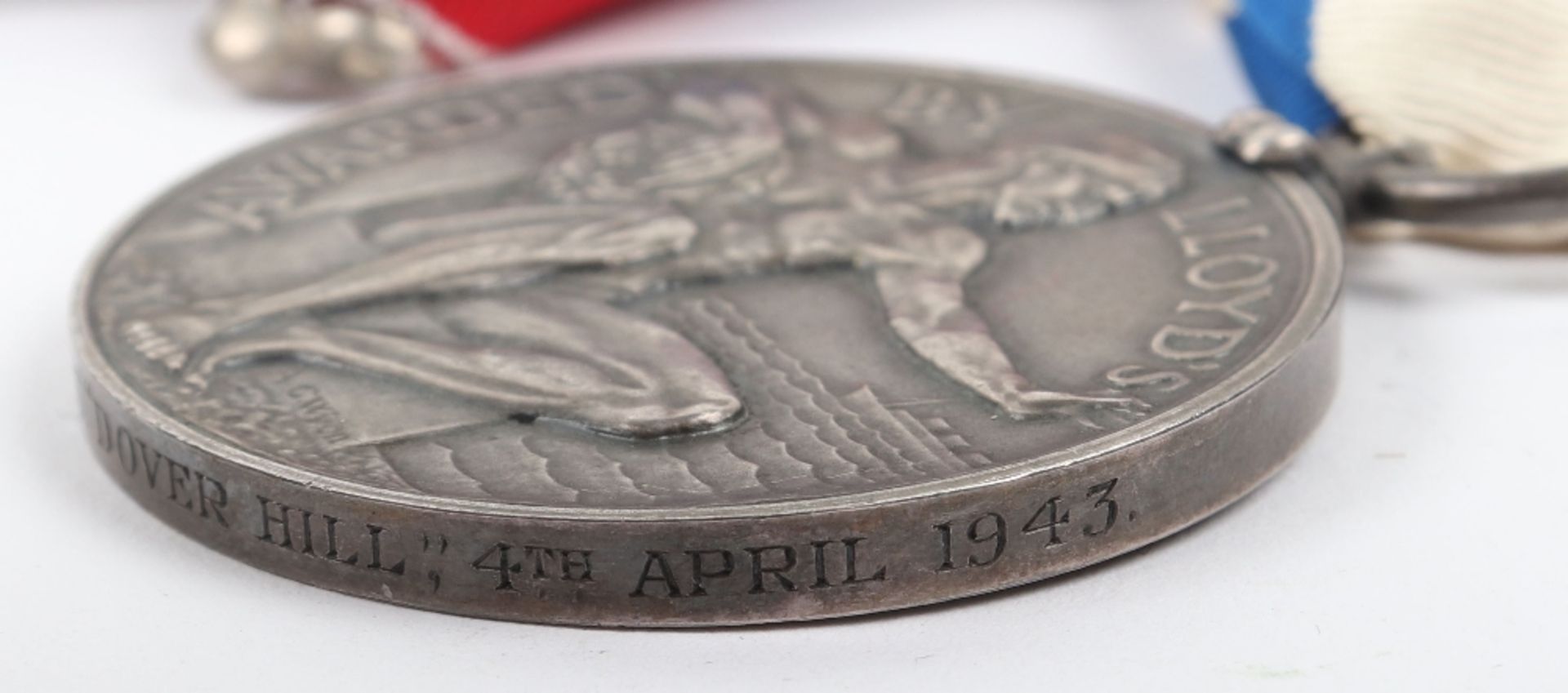41
Rare WW2 Merchant Navy SS Dover Hill Arctic Convoys OBE and Lloyds War Medal for Bravery at Sea Meda
Captain W G Perrin was awarded the O.B.E in the London Gazette 12th October 1943, “For services when the ship was bombed and damaged”. The Lloyds medal appeared in the Lloyd’s List and Shipping Gazette 5 September 1944, “Captain Wilfred Geoffrey Perrin, Master, Dover Hill. For dangerous work in hazardous circumstances. The S.S. Dover Hill, was a cargo vessel of 5,815 tons. She formed part of convoy JW. 53 bound for North Russia heavily laden with a cargo of fighter aircraft, tanks, lorries, guns and ammunition. The convoy comprised of 28 merchant vessels with an escort of three cruisers, one anti-aircraft cruiser, one escort carrier, 16 destroyers, two minesweepers, three corvettes and two trawlers. Such a heavily defended convoy reflected the importance of the cargo and the expectation of trouble from enemy attack”.
The convoy set off on 15 February 1943, in a gale which developed into such a severe storm that six of the merchant ships were so damaged that they were forced to return to Iceland. The S.S. Dover Hill lost much of her deck cargo overboard, including oil drums and crated lorries, but managed to save the tanks and continue her difficult passage northwards. Despite a concerted attack by Ju-88 bombers a few days later the remaining 22 merchant ships of the convoy arrived at the Kola Inlet on 27 February. A few days later S.S. Dover Hill discharged her cargo at Murmansk, still being subjected to frequent attack from enemy bombers, and afterwards moved out to an anchorage in the Kola Inlet where the ships lay about a mile apart. The German front being only about ten miles away, these ships came under frequent low-level attack by Me. 109s and the D.E.M.S. gunners were kept very busy as they patiently awaited their escort home - indeed the gunners aboard S.S. Dover Hill successfully claimed one destroyed and one shared destroyed before the incident occurred whereby the names of several members of her crew appeared in the London Gazette.
The ship’s Radio Officer David Craig, who related his experiences for the online BBC archive WW2 People’s War, “I feel that the story should be told why the names of these men should appear in the London Gazette. I write the story as I remember it but I write on behalf of the nineteen men, as we all worked together and none of us did anything different from anyone else. On Sunday, 4 April we were anchored in Misukovo Anchorage a few miles north of Murmansk and I was playing chess in the Officers’ Mess when Action Stations sounded and our guns opened up at the same time. I went through the pantry, looked out of the door, and saw two Ju. 88 bombers coming up from astern, high up. Our Bofors shells were bursting below them and when they turned away I assumed we had beaten them off and stepped out on deck. This was a foolish thing to do as, unknown to me the planes had released their bombs before turning away. Four bombs exploded close on the port side and one on the starboard side and I was blown off my feet. As I got up our gunlayer came down from one of the bridge oerlikons and pointed out a large round hole in the steel deck a few yards from where I had been standing. It was obvious that the sixth bomb had gone through the main and ‘tween decks into our coal bunkers and had not exploded. We informed the S.B.N.O, Murmansk of the situation and were advised that there were no British Bomb Disposal people in North Russia. We then realised that we would have to dig the bomb out ourselves in order to save our ship. The minesweeper H.M.S. Jason was ordered to anchor astern of us and to come alongside to render assistance if the bomb should explode, although I doubt if there would have been much to pick up. Incidentally, I did enjoy talking to the Jason by Aldis lamp during this time. You must understand that though the Dover Hill was only a battered old Merchantman she was our home and no German was going to make us leave her while she was still afloat. The Captain [Perrin] lined the whole crew up on the after deck and asked for volunteers, and 19 of us including our Captain formed our own Bomb Disposal Squad. We had no bomb disposal equipment, in fact we only had a few shovels borrowed from our stokehold and 19 stout hearts when we started digging back the coal, trying to find the bomb. The bunker was full of good British steaming coal which we were saving for the homeward run so we used a derrick to bring it up on deck, hoping to replace it when we got the bomb out. When the Russian authorities heard what we were doing, although they had many unexploded bombs to deal with in the town, they kindly offered to send one of their Bomb Disposal officers to remove the detonator if we could get the bomb up on deck. When we dug about ten feet down into the coal we found the tail fins and, by their size, decided our bomb must be a 1000lb one. Unfortunately the Germans also discovered what we were up to and came back and bombed us again, hoping to set off the bomb we were digging for. Between bomb explosions and the concussion of our own guns the coal used to fall back into where we were digging and things got difficult at times. We had to dig down approximately 22 feet before we got to the bomb, but after two days and two nights hard work we finally got it up on deck. I was standing beside the bomb with two of my fellow officers as our Russian friend started to unscrew the detonator when after a few turns it stuck. He then took a small hammer and a punch and tapped it to get it moving. I can honestly say that every time he hit it I could feel the hairs on the back of my neck standing against my duffle coat hood. After removing the detonator and primer we dumped the bomb into the Kola Inlet where it probably lies to this day. We then moved back to Murmansk for repairs. Of the 15 ships which had come to Murmansk in February, one had been sunk and four damaged. On 17 May, in company with three other ships we left the Kola Inlet and set out for the White Sea. We arrived in Economia on the North Dvina River where we stayed until 18 July when we moved to Molotovsk (Severodvinsk) and finally on 26 November, with eight other ships, some damaged, we set out for home. Since it was now dark for almost 24 hours each day and we could only do seven knots maximum speed we went north to the edge of the ice. Knowing that a Russian bound convoy was coming up to the south of us we expected the Germans to attack it and leave us alone. This in fact happened and we eventually arrived in London on 14 December 1943, in time to be home for Christmas”.
After returning from North Russia the Dover Hill was taken over by the Ministry of War Transport and was sunk at Arromanches on 9 June 1944 along with other ships to form an artificial port for the invasion of Normandy.
Captain W G Perrin was awarded the O.B.E in the London Gazette 12th October 1943, “For services when the ship was bombed and damaged”. The Lloyds medal appeared in the Lloyd’s List and Shipping Gazette 5 September 1944, “Captain Wilfred Geoffrey Perrin, Master, Dover Hill. For dangerous work in hazardous circumstances. The S.S. Dover Hill, was a cargo vessel of 5,815 tons. She formed part of convoy JW. 53 bound for North Russia heavily laden with a cargo of fighter aircraft, tanks, lorries, guns and ammunition. The convoy comprised of 28 merchant vessels with an escort of three cruisers, one anti-aircraft cruiser, one escort carrier, 16 destroyers, two minesweepers, three corvettes and two trawlers. Such a heavily defended convoy reflected the importance of the cargo and the expectation of trouble from enemy attack”.
The convoy set off on 15 February 1943, in a gale which developed into such a severe storm that six of the merchant ships were so damaged that they were forced to return to Iceland. The S.S. Dover Hill lost much of her deck cargo overboard, including oil drums and crated lorries, but managed to save the tanks and continue her difficult passage northwards. Despite a concerted attack by Ju-88 bombers a few days later the remaining 22 merchant ships of the convoy arrived at the Kola Inlet on 27 February. A few days later S.S. Dover Hill discharged her cargo at Murmansk, still being subjected to frequent attack from enemy bombers, and afterwards moved out to an anchorage in the Kola Inlet where the ships lay about a mile apart. The German front being only about ten miles away, these ships came under frequent low-level attack by Me. 109s and the D.E.M.S. gunners were kept very busy as they patiently awaited their escort home - indeed the gunners aboard S.S. Dover Hill successfully claimed one destroyed and one shared destroyed before the incident occurred whereby the names of several members of her crew appeared in the London Gazette.
The ship’s Radio Officer David Craig, who related his experiences for the online BBC archive WW2 People’s War, “I feel that the story should be told why the names of these men should appear in the London Gazette. I write the story as I remember it but I write on behalf of the nineteen men, as we all worked together and none of us did anything different from anyone else. On Sunday, 4 April we were anchored in Misukovo Anchorage a few miles north of Murmansk and I was playing chess in the Officers’ Mess when Action Stations sounded and our guns opened up at the same time. I went through the pantry, looked out of the door, and saw two Ju. 88 bombers coming up from astern, high up. Our Bofors shells were bursting below them and when they turned away I assumed we had beaten them off and stepped out on deck. This was a foolish thing to do as, unknown to me the planes had released their bombs before turning away. Four bombs exploded close on the port side and one on the starboard side and I was blown off my feet. As I got up our gunlayer came down from one of the bridge oerlikons and pointed out a large round hole in the steel deck a few yards from where I had been standing. It was obvious that the sixth bomb had gone through the main and ‘tween decks into our coal bunkers and had not exploded. We informed the S.B.N.O, Murmansk of the situation and were advised that there were no British Bomb Disposal people in North Russia. We then realised that we would have to dig the bomb out ourselves in order to save our ship. The minesweeper H.M.S. Jason was ordered to anchor astern of us and to come alongside to render assistance if the bomb should explode, although I doubt if there would have been much to pick up. Incidentally, I did enjoy talking to the Jason by Aldis lamp during this time. You must understand that though the Dover Hill was only a battered old Merchantman she was our home and no German was going to make us leave her while she was still afloat. The Captain [Perrin] lined the whole crew up on the after deck and asked for volunteers, and 19 of us including our Captain formed our own Bomb Disposal Squad. We had no bomb disposal equipment, in fact we only had a few shovels borrowed from our stokehold and 19 stout hearts when we started digging back the coal, trying to find the bomb. The bunker was full of good British steaming coal which we were saving for the homeward run so we used a derrick to bring it up on deck, hoping to replace it when we got the bomb out. When the Russian authorities heard what we were doing, although they had many unexploded bombs to deal with in the town, they kindly offered to send one of their Bomb Disposal officers to remove the detonator if we could get the bomb up on deck. When we dug about ten feet down into the coal we found the tail fins and, by their size, decided our bomb must be a 1000lb one. Unfortunately the Germans also discovered what we were up to and came back and bombed us again, hoping to set off the bomb we were digging for. Between bomb explosions and the concussion of our own guns the coal used to fall back into where we were digging and things got difficult at times. We had to dig down approximately 22 feet before we got to the bomb, but after two days and two nights hard work we finally got it up on deck. I was standing beside the bomb with two of my fellow officers as our Russian friend started to unscrew the detonator when after a few turns it stuck. He then took a small hammer and a punch and tapped it to get it moving. I can honestly say that every time he hit it I could feel the hairs on the back of my neck standing against my duffle coat hood. After removing the detonator and primer we dumped the bomb into the Kola Inlet where it probably lies to this day. We then moved back to Murmansk for repairs. Of the 15 ships which had come to Murmansk in February, one had been sunk and four damaged. On 17 May, in company with three other ships we left the Kola Inlet and set out for the White Sea. We arrived in Economia on the North Dvina River where we stayed until 18 July when we moved to Molotovsk (Severodvinsk) and finally on 26 November, with eight other ships, some damaged, we set out for home. Since it was now dark for almost 24 hours each day and we could only do seven knots maximum speed we went north to the edge of the ice. Knowing that a Russian bound convoy was coming up to the south of us we expected the Germans to attack it and leave us alone. This in fact happened and we eventually arrived in London on 14 December 1943, in time to be home for Christmas”.
After returning from North Russia the Dover Hill was taken over by the Ministry of War Transport and was sunk at Arromanches on 9 June 1944 along with other ships to form an artificial port for the invasion of Normandy.
Fine Militaria Auction
Sale Date(s)
Venue Address
Viewing for this auction is by appointment only, please contact our office to arrange viewing. You will need to tell us the lot(s) you wish to view prior to your arrival at our office so we can have these ready. We are not able to offer any viewing on the day of the auction.
- C&T Auctioneers and Valuers Ltd offer an in house post and packing service for most auctions, except our specialist Toy Soldiers and Figures Auctions,which is conducted by Mailboxes Tunbridge Wells or Jentel Packing.
- We are not able to offer in house post and packing on invoice totals over £3,000 or very fragile, large or heavy items. These items will also need to be shipped by specialist shippers.
From the 1st of January 2021 all sales from the UK to EU customers will be treated as exports. These can be zero rated for UK VAT purposes, as currently applied for non-EU countries. But, items depending on their value and nature, may become liable to import VAT (and customs duty where applicable) when entering the EU (This is the responsability of the buyer).
Please contact our office 01233 510050 for further information.
- PLEASE NOTE DUE TO NEW RESTRICTIONS, ALL PURCHASERS OF ANY EDGED WEAPON WILL NEED TO PROVIDE US WITH PROOF OF AGE (OVER 18) BEFORE THE ITEM CAN BE SHIPPED.
- ALL LOTS WITH ^ PREFIX CONTAIN IVORY OR ANOTHER PROPERTY THAT WILL REQUIRE CITES LICENSE BEFORE BEING SHIPPED OUTSIDE OF THE EU. PLEASE MAKE SURE YOU CAN LEGALLY IMPORT INTO YOUR COUNTRY OF RESIDENCE ANY ITEM BEFORE BIDDING IN THE AUCTION.
- ANTIQUE FIRE ARMS CAN NOT BE SHIPPED OUTSIDE OF THE UK
C&T Auctioneers and Valuers are not responsible for any damage caused when items are in transit with postal or courier firms. We are also not responsible for any package sent either by ourselves or any third party company which is lost in transit.
For lots we are not able to offer in house shipping;
We can recommend the following companies for shipping, who will be happy to quote and pick up:
MailBoxes TunbridgeWells
t: 01892510155
Email:greg@mbetunbridgewells.co.uk
Jentel Packing
t: 01268 776777
Email: enquiries@jentelpacking.co.uk
Collections
Coronavirus (COVID-19) • After the auction lot(s) can only be collected from our office, by appointment only and must be paid for in full, prior to your arrival, with social distancing consideration in place
Current Office opening hours for collections Monday to Thursday 10.00 am to 4.00pm
C & T Auctioneers and Valuers Ltd
Unit 4 High House Business Park
Kenardington
Nr Ashford TN26 2LF.
Tel: 01233510050
PLEASE READ OUR TERMS AND CONDITIONS BEFORE BIDDING THANK YOU.
Important Information
This auction has been placed over two days to allow more time for Internet bidders
Day One Wednesday 17th February 2021 10.30 GMT Lots 1 to 373
Day Two Thursday 18th February 2021 10.30 GMT Lots 374 to 676
The following lots have been withdrawn from the sale:
55, 254 , 256 , 259 , 303 , 304 , 305 , 340 , 343 , 346 , 348 , 349 , 350 , 622 , 624 , 625 , 626 , 627 , 628 & 649
From the 1st of January 2021 all sales from the UK to EU customers will be treated as exports. These can be zero rated for UK VAT purposes, as currently applied for non-EU countries. But, items depending on their value and nature, may become liable to import VAT (and customs duty where applicable) when entering the EU (This is the responsability of the buyer).
Terms & Conditions
Buyers Premium: Winning bidders agree to pay the winning bid plus the buyers premium charged by the auction house, this is currently 22% + VAT (26.4% total). Buyers purchasing via an online live bidding platform the-saleroom.com will be charged an additional 4.95% + VAT on the hammer price.
If you are successful in an auction with an absentee, telephone or internet bid, you will be invoiced, normally within 48 hours of the auction taking place. This invoice will normally include a shipping quote. These invoices are sent via email and have an attachment. Once you have had this invoice we require full payment within 7 days, unless another arrangement has been made with the auction house. Items must be collected from C&T Auctioneers and Valuers within 7 days of payment being made, unless agreement is in place with C&T Auctioneers and Valuers.
Shipping
C&T Auctioneers and Valuers offer an in house postal service for this auction, unless stated. However if an item(s) are too large or need specialist shipping methods, this will be conducted by a third party firm.This also relates to lots of a certain value.
C&T Auctioneers and Valuers are not responsible for any damage caused when items are in transit with postal or courier firms. We are also not responsible for any package sent either by ourselves or any third party company which is lost in transit.
PLEASE READ OUR TERMS AND CONDITIONS BELOW BEFORE BIDDING THANK YOU
Terms & Conditions
When participating in an auction conducted by C&T Auctioneers and Valuers you are bound by these conditions without exception. All public auctions held by C&T Auctioneers and Valuers are exempt from the Sale of Goods Act. Please make sure that you agree and understand these conditions.
BUYER
1: C&T Auctioneers and Valuers at no point are the legal owners of the lots offered in our auctions. We act solely as an agent between the Vendor and the Buyer.
2: The highest bidder of any lot will not become the legal owner of the lot until all associated fees have been paid to the Auction House, this includes any fees charged by the auction house.
3: Winning bidders agree to pay the winning bid plus the buyers premium charged by the auction house, this is currently 22% + VAT (26.4% total). Buyers purchasing via a online live bidding platform will be charged an additional 4.95% + VAT on the hammer price.
4: When registering for our auctions you may be required to provide proof of identity and address. If registering for absentee or telephone bids a form of payment method must be left with the auctioneers.
5: It is the responsibility of the bidder to insure that all absentee bids are left with the auction house at least 24 hours before an auction takes place. No bids will be accepted on the day of the auction, unless you are known to the auction house or have an agreement with the auctioneer. C&T Auctioneers and Valuers are not responsible for any errors on a bidding sheet. C&T Auctioneers make every effort to insure all bids left are placed on the auctioneers book, however we cannot accept reliability for any failure to receive or place any bids.
6: If two identical bids are left on one lot, the bid received first will take preference.
7: Telephone bids will only be accepted for lots with a bottom pre sale estimate of £200 or more. Telephone bids will only be accepted for lots with a pre sale estimate of under £200 if you are bidding on multiple lots which equal over £100 or are known to the auction house and have an agreement in place. International bidders we will only accept telephone bids on lots with a pre sale estimate of £500 or more.
8: Bids are accepted solely at the auctioneers discretion. The auctioneer has the legal right to re-open any lot in the auction, even if the hammer has come down. Any bids left via a third party, including a online bidding platform, are not classed as absentee bids and are taken as if a room bid. This may mean that the maximum bid you have left will fall on the bidder in the room, C&T Auctioneers and Valuers are not liable or responsible for any failure for your bid to be executed. C&T Auctioneers and Valuers are also not responsible for any error or problem with any bidding platform software used in the room or at the bidders location.
9: Conditions stated of items are the opinion of the cataloguer for the auction house. It is advised that interested bidders should view items in person or ask for condition reports of any defects. Condition will not be accepted for a reason to return a lot.
10: Some items may be referred to as “gold grade”, this does not mean that the item is made of gold, please make sure you check with us before bidding.
11: Originality of items offered for sale in C&T Auctioneers and Valuers are the opinion of the specialist employed by the auction house. All bidders should make sure that they are happy with the originality of any item they intend to bid on.
12: Any statement made in the description of a lot is the opinion of the specialist cataloguer and will be either from evidence he or she has at the time of writing the description, this may also be information provided by the vendor of the lot. We advise all bidders to confirm this information before the auction takes place.
13: If bidders and buyers who are not experts in the lots they are interested in, we would recommend that they seek independent advice on the lots and the value before bidding.
14: All successful buyers in the auction room, must pay and collect their items on the day of the sale unless an agreement is in place with the auction house.
15: If you are successful in an auction with an absentee, telephone or internet bid, you will be invoiced, normally within 48 hours of the auction taking place. This invoice will normally include a shipping quote. These invoices are sent via email and have an attachment. Once you have had this invoice we require full payment within 7 days, unless another arrangement has been made with the auction house. Items must be collected from C&T Auctioneers and Valuers within 7 days of payment being made, unless agreement is in place with C&T Auctioneers and Valuers.
16: C&T Auctioneers and Valuers do offer an in house postal service for most items in our auctions, unless stated. However if an item(s) are too large or need specialist shipping methods, this will be conducted by a third party firm. Details of the firm we recommend will be passed onto buyers in this case. This also relates to lots of a certain value. PLEASE NOTE C&T AUCTIONEERS AND VALUERS ARE NOT A SHIPPING COMPANY, WE WOULD ASK ALL BUYERS TO BE PATIENT AND ITEMS ARE DEALT WITH ON A FIRST COME FIRST SERVE BASIS.
17: C&T Auctioneers and Valuers are not responsible for any damage caused when items are in transit with postal / courier firms. We are also not responsible for any package sent either by ourselves or any third party company which is lost in transit.
18: C&T Auctioneers and Valuers declare the full value of any lot sent to international buyers. We are not responsible for any customs import charges of the country of destination. It is the buyers responsibility to make sure they can legally import the item into their country. We advise international buyers if they are not sure of any import issue, to obtain independent advice.
19: C&T Auctioneers and Valuers accept the following methods of payment, Cash in UK pounds sterling up to £3,000, Personal Cheques (must clear before goods are dispatched), Debit cards, Credit cards (2% surcharge will be added if paying with a credit card from clients outside the EU only), Bank Transfers (Please note that if paying by this method the amount received after the deduction of any bank fees or currency conversion of payment to UK pound sterling must not be less than the sterling amount payable as set out on the invoice).
Credit card payments where the card holder is not present will only be accepted for transactions up to £500.
20: If you purchase an item and you are not happy with the originality of an item you must contact the auction house within 7 days of receiving the lot(s), it is then solely up to the auctioneers discretion to issue a refund. Proof of error in description may be required, this is the responsibility of the purchaser to obtain this information and any fees associated with this are not refundable by C&T Auctioneers and Valuers. We will only accept information by a professional in the chosen field, we will not accept any information from a private individual or internet collectors forum. Any payment fees or postage fees associated with any lot can not be refunded.
21: If originality of an item is accepted proven after the vendor has been paid for a lot, it is up to the vendor, if they are willing to issue a refund. C&T Auctioneers and Valuers are unable to offer a refund without having an agreement from the vendor. Refunds will only be issued to the purchaser of the item and not if the item has been given or sold to a third party.
23: Items purchased must be posted, collected and removed from our premises within two weeks following the sale. Thereafter a daily storage charge of £2 per lot + VAT at prevailing rate. Continued failure to collect or arrange shipping will result in the goods being sold without further notice and without reserve to recover the costs for storage unless agreement has been made in writing with us.
24: All items sold are sold as collectors items, recommended for display use only and we do not advise or take any responsibility if used for the purpose for which they were designed for.
25: Any lots with the following symbol ^, will indicate that a CITES license will be required before the lot can be shipped outside of the EU.
26. UK:All items are sold under the auctioneers margin scheme.
From the 1st of January 2021 all sales from the UK to EU customers will be treated as exports. These can be zero rated for UK VAT purposes, as currently applied for non-EU countries. But, items depending on their value and nature, may become liable to import VAT (and customs duty where applicable) when entering the EU (This is the responsibility of the buyer).












